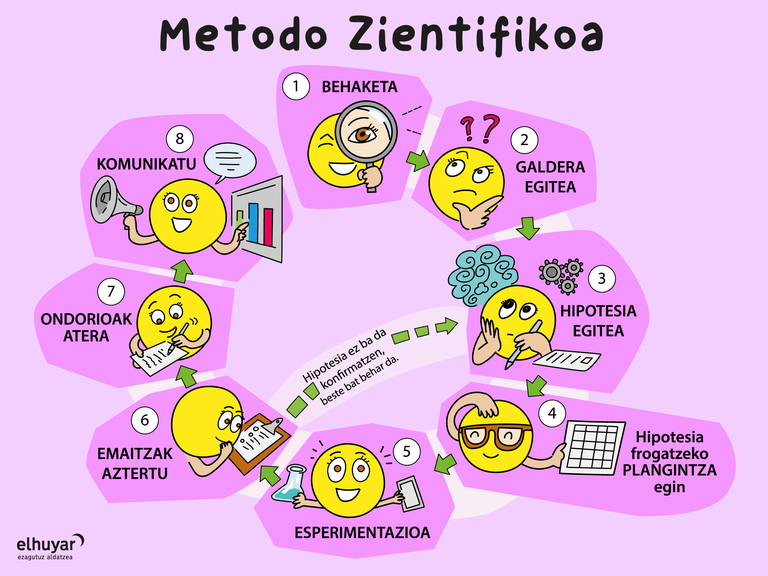Text written in Basque and translated automatically by Elia without any subsequent editing. SEE ORIGINAL
Scientific method

Below are the most common steps of the scientific method.
- Observation: We look at the world and focus on what we want to understand. That is observing. Curiosity leads us to human observation naturally.
- Starting from a scientific question: Following the observation, the next step is to ask a question that will guide the research process. Many questions suggest scientific curiosity, but only some are investigable. The research question must be clear, concrete, feasible, new and ethical.
- Hypothesis: The hypothesis is the compass that guides the research; it reflects what we are looking for or testing. It is also possible to answer the research question, explaining as clearly and concisely as possible the relationship between dependent variables and independent variables. The hypothesis must be accepted or rejected through testing, observation and experimentation.
- Plan the hypothesis: It determines what will be done and how long it will be done, evaluating the resources and assigning the works to the work team.
- Performing experimentation or field work: To experiment is to develop actions aimed at finding, verifying or demonstrating a scientific phenomenon or principle. It is convenient to change a single variable at once, keeping the rest constant. In the field work, specific notes of each experiment, measurement and observation will be taken. A good record informs the process and helps base the work analysis. The strength of the research depends heavily on this. Collect observations on expected and unexpected events: additional questions, concerns, procedural changes, new ideas…
- Analysis and discussion of results: Once the research is completed, the results will be analyzed. Previously we must check if there is sufficient evidence to accept or reject our hypothesis. For the debate it is essential to compare the results obtained with the theoretical values, with the data of other research and with the expected results.
- Conclusions: It is time to summarize the main discoveries of the work. It should be specific, not generalized, and never include something that has not been done in the project. Experimental research does not always confirm the hypothesis, but in some cases denies it. This does not invalidate the process: the desired conclusion may not be reached, but another important discovery has been made.
- Communication: Science and technology have managed to understand and transform our reality thanks to small and large researches fed each other. That is why it is so important to communicate the project carried out.
To delve into the contents click here.
Buletina
Bidali zure helbide elektronikoa eta jaso asteroko buletina zure sarrera-ontzian











